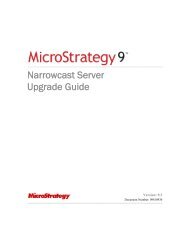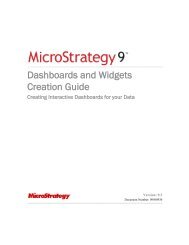Report Services Document Analysis Guide - MicroStrategy
Report Services Document Analysis Guide - MicroStrategy
Report Services Document Analysis Guide - MicroStrategy
You also want an ePaper? Increase the reach of your titles
YUMPU automatically turns print PDFs into web optimized ePapers that Google loves.
<strong>Report</strong> <strong>Services</strong> <strong>Document</strong> <strong>Analysis</strong> <strong>Guide</strong> Analyzing <strong>Document</strong>s in <strong>MicroStrategy</strong> Web 3<br />
Use Flash View in Desktop and Express Mode, Flash Mode, and Interactive<br />
Mode in <strong>MicroStrategy</strong> Web to interact with widgets. In Flash View in<br />
Desktop and in Express Mode in <strong>MicroStrategy</strong> Web, you cannot save your<br />
changes.<br />
You can also view certain widgets on mobile devices that have <strong>MicroStrategy</strong><br />
Mobile, as described in Widgets for mobile devices, page 85.<br />
Types of widgets<br />
The sections below describe each type of widget, its purpose, and how you<br />
can use it to analyze a specific set of data while working in <strong>MicroStrategy</strong><br />
Web. The following list briefly summarizes each type of widget that can be<br />
used in a document:<br />
• Bubble Grid: Bubbles of different colors and sizes representing the<br />
values of two metrics. It can help identify important trends or anomalies<br />
in data, relative to the total contribution of accompanying data. See<br />
Analyzing a Bubble Grid widget, page 85 for more details and an<br />
example.<br />
• Cylinder: A simple status indicator that displays a vertical cylinder with<br />
fluid in it. The level of the fluid within the cylinder is a visual<br />
representation of a single metric value. See Analyzing a Cylinder widget,<br />
page 87 for more details and an example.<br />
• Data Cloud: A list of attribute elements displayed in various sizes to<br />
depict the differences in metric values between the elements. The varying<br />
sizes allow you to quickly identify the most significant, positive, or<br />
negative contributions. See Analyzing a Data Cloud widget, page 88 for<br />
more details and an example.<br />
• Date Selection: A calendar selector that allows you to select which dates<br />
you want to see data about in a document or dashboard. You are able to<br />
see all of the dates of each month in the widget, which allows you to be<br />
able to select dates more easily. See Using a Date Selection widget,<br />
page 89 for more details and an example.<br />
• Fish Eye Selector: An interactive selector that magnifies an item when<br />
you hover the cursor over it. It allows a user to choose from a list of<br />
attribute elements, metrics, or images without having to see all of the<br />
elements, metrics, or images. Any item that a user hovers over or selects<br />
remains magnified, while the remaining items are minimized and hidden<br />
from view. This can be especially helpful when the user has to browse<br />
© 2012 <strong>MicroStrategy</strong>, Inc. Flash analysis and interactivity: widgets 83


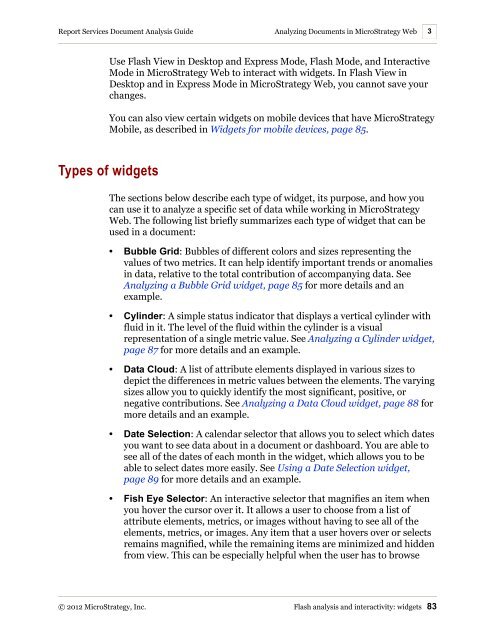
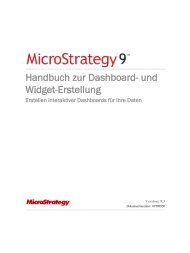
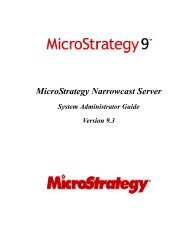
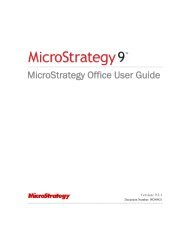
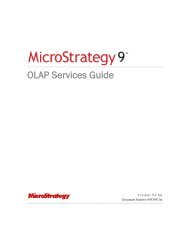
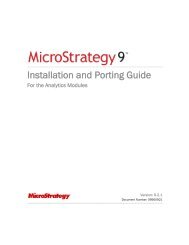

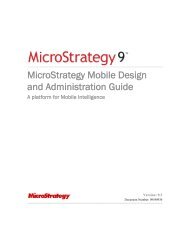
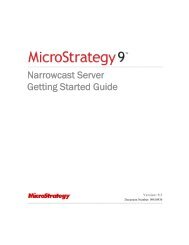

![The New Era of Mobile Intelligence: [PDF] - MicroStrategy](https://img.yumpu.com/13859921/1/190x245/the-new-era-of-mobile-intelligence-pdf-microstrategy.jpg?quality=85)
![customer success story [pdf] - MicroStrategy](https://img.yumpu.com/13859884/1/190x146/customer-success-story-pdf-microstrategy.jpg?quality=85)
![Call for Speakers Guide [PDF] - MicroStrategy](https://img.yumpu.com/13859856/1/190x245/call-for-speakers-guide-pdf-microstrategy.jpg?quality=85)
